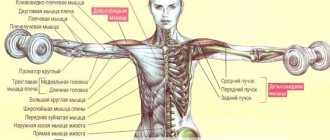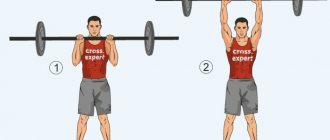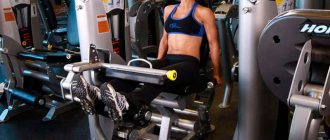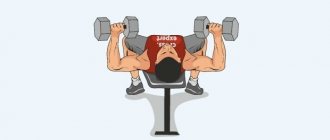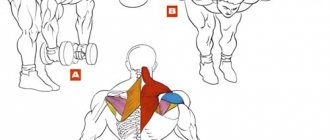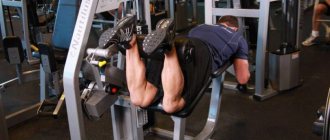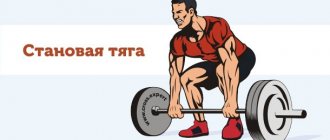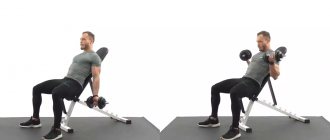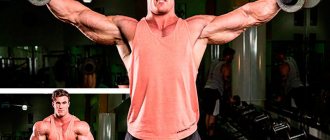In the formation of a beautiful symmetrical silhouette for girls or the creation of a “triangle” figure for men, the development of the deltoid muscles, that is, the superficial muscles of the shoulders, plays an important role. There are a lot of exercises for this muscle group. Some of them are isolated, which allow you to pump this particular area, others are basic, which involve almost the entire body. Today we will talk about the second option, namely the standing dumbbell press.
- Standing dumbbell press. What muscles work?
- Benefits of the Standing Dumbbell Press
- Standing Dumbbell Press Options
- Standing dumbbell press with both hands at the same time
- Dumbbell press up while standing alternately
- Video: technique for performing dumbbell overhead press while standing alternately
- Standing dumbbell press with one hand
- Standing dumbbell press with wrist rotation
- Common mistakes and recommendations for performing the exercise
Standing dumbbell press. What muscles work?
As we have already noted, this exercise is a basic one. It allows you to build muscle mass and give your shoulders the desired rounded shape.
The deltoid muscles consist of three small bundles - the anterior deltoid, middle deltoid and posterior deltoid.
In this exercise, the front deltoids are primarily loaded. To a slightly lesser extent, the middle deltas are included in the work. The rear delts are practically not involved.
Muscles that help perform exercises (synergists): middle and lower trapezius, triceps, pectoral muscles, serratus abdominal muscles.
For stabilization, the long head of the triceps, biceps, and upper back (upper trapezius) are included in the work.
Muscles working during the standing dumbbell press exercise.
Depending on the position of the hands, the load can be slightly redistributed between the delta bundles, but not significantly.
Muscle atlas
In different variations, the standing military dumbbell press can engage a huge number of small muscle groups.
| Muscle group | Load | Types of exercises |
| Extensor arm triceps | Significant accent | Standing Dumbbell Press, Military Press, Shung Press, Standing Arnold Press |
| Lateral head of triceps | Slight emphasis | Standing dumbbell press, military press |
| Wrist muscles | Static loading | Standing Dumbbell Press, Military Press, Shung Press, Standing Arnold Press |
| Upper delta | Dynamic basis | Standing Dumbbell Press, Military Press, Shung Press |
| Anterior delta | Slight emphasis | Arnold Press |
| Collar | Basic load | Arnold Press |
| Upper bundle of pectoral muscles | Slight emphasis | Army press |
| Muscles of the lumbar region | Stabilizing load | Standing Dumbbell Press, Military Press, Shung Press, Standing Arnold Press |
| Thigh muscles | Blasting load | Shung press |
| Quadriceps | Blasting load | Shung press |
In its basic variation, this exercise primarily involves:
- Upper deltas.
- Triceps.
- Lumbar region.
As can be seen from the muscle atlas, this exercise is multi-joint, but its load is not enough to generally shock the body and increase the level of anabolism. That is why it is included in split programs, and not added to the classic “press-dead-squat” trio. At the same time, if we are talking about functional lifting strength and impact force, then a better exercise than the dumbbell upward press has not yet been invented.
Benefits of the Standing Dumbbell Press
The benefits of this exercise should be considered in comparison with other types of exercises that are used to work the deltoid muscles - for example, seated dumbbell press or standing barbell press, as well as some isolated shoulder exercises.
- The standing dumbbell press, unlike the barbell press, allows both arms to act independently, developing the weaker side and allowing it to catch up in strength and symmetry to the other.
- The amplitude when working with dumbbells can increase significantly compared to the barbell bench press.
- The seated dumbbell press somewhat isolates the shoulder girdle, minimizing the work of the stabilizers and related muscles. And this is not bad for the expedient increase in shoulder muscles, but it interferes with the development of strength and improvement of performance in other exercises.
- The next advantage smoothly follows from the previous one. The standing dumbbell press allows you to increase the overall strength of the athlete (like all basic exercises), as well as improve the results of the bench press.
- During a standing dumbbell press, a large number of muscles and joints are activated and worked out, the body learns to act cohesively, and the athlete begins to feel and control the core muscles better.
- It is easier to get injured during an isolated exercise on the deltoids, since these bundles are initially quite small and weak. When doing a standing press, the load is distributed evenly, which minimizes the possibility of shoulder injury.
However, it is worth understanding that if you are determined to work with heavy weights, the dumbbell press will not be suitable, since the total weight of the dumbbells will always be less than what can be pressed with a barbell.
What does it mean?
Although your working weight will be lower in standing presses, muscle activity of the deltoids will be higher by an average of 15.6%! This means that standing dumbbell presses are a great addition to your training program.
In addition, this exercise has one more advantage: in a standing position, you will have to spend strength to keep your body in an upright position. Your core muscles will work to stabilize your body. And strong core muscles are the key to progress in weights in almost all basic exercises - the same deadlift and squats.
Plus, with a strong core, the difference in working weight between standing and seated presses will be reduced, giving you an even greater advantage.
Standing Dumbbell Press Options
There are several variations of this exercise that allow you to slightly shift the emphasis of the load between the deltas and perform different tasks.
Standing dumbbell press with both hands at the same time
Let's first consider the classic version of the exercise, in which the athlete simultaneously raises both arms.
Technique of the exercise: bench press dumbbells with both hands at the same time while standing.
Exercise technique:
- We take dumbbells in our hands and stand up straight.
- We place our legs approximately shoulder width apart, feet parallel to each other.
- Raise your arms with dumbbells so that your shoulders are parallel to the floor and the angle at your elbows is about 90 degrees.
- As you exhale, raise your arms with the dumbbells up, but without straightening your elbows completely.
- At the top point, try not to hit the dumbbells against each other: they should not converge.
- Hold at the top point for a couple of seconds and inhale as you return to the starting position.
If you are doing an exercise to increase muscle size, then do 6-8 repetitions in 3-4 sets. In this case, it is advisable to take more weight.
If your goal is to increase endurance or lose weight, perform 10-12 repetitions in 4-5 sets, but with less weight.
Dumbbell press up while standing alternately
Given that the deltoids are often weak muscles, the standing press can be somewhat difficult for beginners. In this case, you can try pressing dumbbells one at a time. However, it is difficult to do this option with a large weight - there is no counterweight. The method of performing an alternating press is almost similar to the previous version.
Exercise technique:
- We stand straight, feet shoulder-width apart, raise the dumbbells above shoulder level.
- As you exhale, press one dumbbell up, as you exhale, return your arm to its original position, and as you exhale, press the other.
Perform 6-8 repetitions with each arm for 3-4 sets if you are doing the exercise to build muscle. And 10-12 reps for 4-5 sets if you're looking to build endurance or lose weight.
Video: technique for performing dumbbell overhead press while standing alternately
Video of dumbbell overhead press while standing alternately
Standing dumbbell press with one hand
This exercise is also an excellent option for a beginner and allows you to properly master the technique. In addition, this option is suitable for an athlete who wants to achieve symmetry or has suffered a shoulder injury, and can use different weights for each arm. The one-arm standing press can be conveniently performed not only with dumbbells, but also with a kettlebell.
Technique of the dumbbell press exercise while standing with one hand.
Exercise technique:
- The starting position is the same as in the previous versions: we place our feet shoulder-width apart, keep our back straight, tighten our stomach, and tense our abs.
- The difference is that we take the projectile in only one hand, the other can be placed on the waist.
- Hold the dumbbell at shoulder level, elbow bent at an acute angle.
- With an exhalation, we begin to squeeze the dumbbell upward, without straightening the elbow completely.
- After 10–12 repetitions with one hand, perform the exercise with the other.
Standing dumbbell press with wrist rotation
All of the above types of dumbbell presses can be performed by turning the hands inward during the movement so that they are parallel to each other. In this way, we increase the emphasis on the anterior deltoid and include more pectoral muscles in the work, just as in the “Arnold press” exercise, which is aimed at simultaneously working the chest and shoulders.
Why is it important to do this exercise and alternate the press with different hand placements? As we have already said, the pectoral muscles help perform this movement, and without well-developed pectoral muscles, a press with a large weight and good amplitude will not be possible. In addition, you can improve your bench press performance.
Exercise technique:
- Regardless of what type of press (simultaneous, alternating or one-armed) you choose, we get into the starting position - feet shoulder-width apart, shoulder blades pulled together, chest open, gaze directed straight ahead.
- We hold our hands with dumbbells at shoulder level or slightly higher. Palms face forward.
- As you exhale, we begin to squeeze the dumbbells upward, while simultaneously turning our hands so that they look at each other at the top.
- As you inhale, return to the starting position and repeat.
We do the exercise for 6–8 repetitions, 3–4 working approaches to increase muscle volume. Or 8-15 times, 4-5 approaches for drying and improving endurance.
Contraindications
It is believed that there are only two of them:
- Abdominal surgery (rehabilitation takes six months);
- Shoulder injuries
In fact, there are more of them. There is no need to perform swings and lifts in case of spasms of the trapezius muscle, exacerbation of pain due to osteochondrosis or arthrosis. It also makes sense to eliminate assistance exercises if an athlete is having trouble recovering from heavy lifts.
This movement does not need to be included in the plan “instead of” dumbbell and barbell shoulder presses if the goal is to completely unload the joint. If there are problems with recovery, it makes sense for the athlete to choose complete rest for several days, or pressing movements with light rubber, but not swings with weights.
DUMBBELL SWINGS IN FRONT OF YOU
Common mistakes and recommendations for performing the exercise
The most common mistakes that beginners make:
- The exercise can be difficult at first, because the deltoid muscles, as we have already said, are initially small and rather weak, so many, when performing this exercise, actively engage the body in the work, swinging and giving impulse to squeeze the dumbbell more easily.
- The mistake is to perform the exercise in jerks or at high speed.
- Don't try to follow the movement of your hands by turning your head. Look straight in the mirror if you are not sure of the correct execution, but you do not need to turn your head. This can lead to cervical injuries.
Useful tips will help you perform the exercise as efficiently and safely as possible:
- There cannot be the same instructions for all athletes regarding wrist rotation and range of motion. If someone can bench press very high range of motion without any problem and has good results, your joint mobility may not allow you to do it as easily. Look for a position that is comfortable for you.
- Be sure to warm up your shoulder girdle before performing the exercise, otherwise there is a high risk of injury.
- If you have any problems with your back, especially your lower back, it is best to try doing the seated press.
- In order to prevent the body from staggering and swaying, it is necessary to keep your abs and back under control at all times and not relax them.
In conclusion, we note that although the standing dumbbell press can give the shoulders an impressive spherical shape that men so strive for, girls should not avoid this exercise. To build muscle mass and make your shoulders truly stand out, you need to lift heavy weights. If you perform the exercise with dumbbells up to 5 kg for 10-12 repetitions, you can make your shoulders chiseled and attractive.
If you want to do the exercise standing, but you can’t yet
If the muscles of the lower back are not strong enough, include planks, hyperextensions, and deadlifts with light weights under the supervision of a trainer in your training program.
At the same time, it is worth strengthening other core muscles. Press - with the help of twisting and hanging leg raises. The muscles of the back of the thigh - with platform presses and squats, including with a barbell. Gluteal - glute bridges and forward lunges.
deltoid rear delta anterior delta middle delta home workouts
Charger
Intensive exercise will help to “boost” your metabolism throughout the day. It must be performed immediately after waking up, on an empty stomach (drinking still water is allowed).
As a morning exercise, dance aerobics with dumbbells is most effective. The technique combines strength and aerobic elements, helps saturate tissues with oxygen, improve muscle tone, prepare the heart and other internal organs for upcoming strength loads.
Sequence of implementation:
- Turn on dynamic music.
- Take 2 small dumbbells in your hands.
- To the beat of the rhythm in a non-stop style, perform a series of movements with your arms and body: lifting dumbbells in different directions, turning and bending your torso, lifting your legs, jumping in place, lunging forward.
The duration and intensity of exercise should depend on the age, weight and level of functional training of the woman. In most cases, morning exercises with dumbbells are performed at an average pace for 10-15 minutes.
In order not to cause harm to the body, beginners should monitor their pulse during exercise. The maximum permissible number of heartbeats at peak load is calculated by the formula: 220 minus age.
